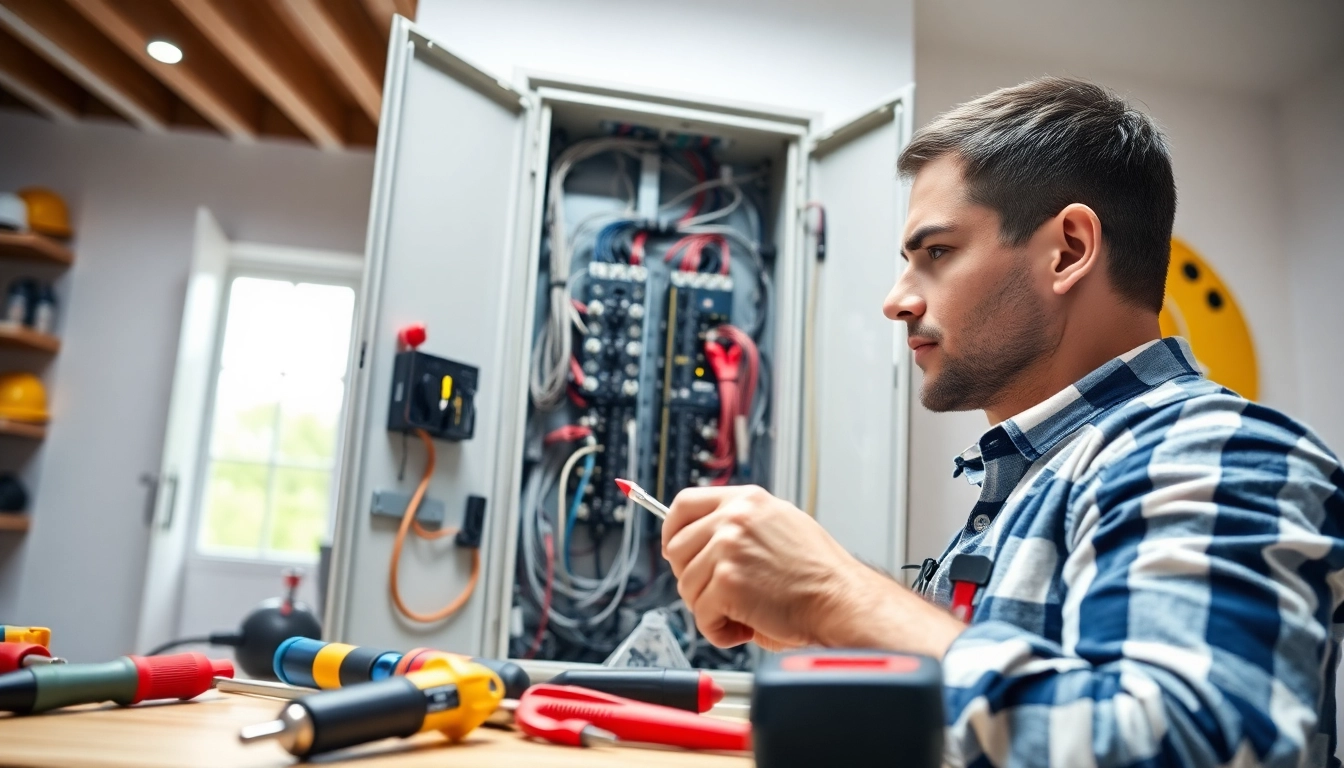Understanding the Importance of Electrical Panel Upgrade
The electrical panel serves as the heart of your home’s electrical system, managing and distributing the electrical power required for your household needs. As our lifestyles evolve, so do our electrical demands. Consequently, many homeowners are faced with the question of when and why they should consider an Electrical Panel Upgrade. In this guide, we explore the significance of electrical panel upgrades, the signs indicating an upgrade is necessary, the procedure for upgrading, and much more.
What is an Electrical Panel?
An electrical panel, also known as a breaker box or service panel, is the component of your electrical system that distributes electricity throughout your home. It receives power from your utility company and sends it to various circuits designated for different appliances or areas in your house. It contains circuit breakers that prevent overloads and shorts by interrupting the electrical flow when necessary.
Why Upgrade Your Electrical Panel?
Upgrading your electrical panel outfitted with newer technology and improved capacity can be crucial for several reasons:
- Increased Capacity: Older panels may not support the power demands of modern appliances or multiple devices. Upgrading to a higher amperage panel (e.g., from 100A to 200A) allows for more circuits and electrical flow.
- Safety: Older electrical panels may increase the risk of electrical hazards such as fires. Newer panels comply with updated safety standards, providing essential circuit overload protection.
- Increased Home Value: An upgraded electrical panel increases the overall value and appeal of your home, particularly if you plan on selling it.
- Accommodating New Appliances: With the rise of energy-hungry appliances (such as electric vehicle chargers, HVAC systems, etc.), upgrading ensures that your home can accommodate current and future power needs.
Signs You Need an Electrical Panel Upgrade
Recognizing that you need an upgrade can save you from potential electrical hazards and improve your home’s efficiency. Watch for these warning signs:
- Frequent Circuit Breaker Trips: If your circuit breakers frequently trip, it indicates that your panel may be overloaded and unable to handle the current load.
- Flickering Lights: Dimming or flickering lights, especially when you turn on certain appliances, may suggest a poorly functioning or overloaded panel.
- Burning Smell: If you detect a burning odor near your panel, you should act immediately as it likely indicates overheating or a potential fire hazard.
- Pre-1970s Panel: If your home still uses an electrical panel installed before the 1970s, it may be outdated and in need of an upgrade to meet modern standards.
- Limited Outlet Availability: If you find yourself using extension cords frequently, it’s a sign that your panel isn’t sufficient for your current electrical load.
Assessing Your Home’s Electrical Needs
Current Electrical Load Analysis
Understanding your current electrical load is essential when determining if an upgrade is necessary. Start by identifying all major appliances and their power requirements. For instance, consider the following common appliances:
- Refrigerator: 100-800 watts
- Washing Machine: 500-1500 watts
- Electric Oven: 2,000-5,000 watts
- HVAC System: 2,500-5,000 watts or more depending on the model and efficiency
By summing the wattage requirements of all your appliances and then converting that number into amperage (using the formula Watts = Volts x Amps), you can get a clear picture of your current power usage. Comparing this against your panel’s capacity will help identify whether an upgrade is needed.
Future-Proofing Your Electrical System
The electrical landscape is rapidly changing with the addition of smart home technology and energy-efficient devices. Future-proofing your electrical system ensures it can adapt to evolving electrical needs over time. Consider the potential for adding:
- Electric vehicle chargers
- Home automation systems
- Additional circuit breakers for new appliances
- Increased capacity for renewable energy sources like solar panels
Addressing these potential future needs during your electrical panel upgrade can mitigate the need for another upgrade shortly after.
Identifying Appliances That Demand More Power
Some appliances require significantly more power than others. It’s critical to recognize these high-demand devices. Adding or replacing just one of these appliances can push your electrical demands over the limit of your existing panel:
- Electric Water Heaters: Use a substantial amount of energy and can be a significant consideration when assessing load.
- Electric Dryers: Similar to water heaters, these require robust electric service, especially in conjunction with other appliances.
- Power Tools: In workshops or home offices, power tools can also add significant load.
Evaluating your home’s unique electrical demands based on appliances will provide clarity regarding how much additional capacity you might need.
The Electrical Panel Upgrade Process
Step-by-Step Guide to Upgrading
The electrical panel upgrade process involves several important steps, and it’s crucial to approach the task methodically and safely:
- Assessment and Planning: Evaluate your current and future electrical needs and decide on the amperage required.
- Choose Your Panel: Select a panel that meets your needs with appropriate space for future breakers.
- Obtain Permits: Check local building regulations and obtain necessary permits.
- Power Down the Main Source: Ensure safety by shutting off the main power supply.
- Install the New Panel: Carefully remove the old panel and install the new one, connecting each circuit accordingly.
- Test the System: After installation, test your electrical system to ensure it works properly and safely.
Due to the risks associated with electrical work, many homeowners choose to hire a licensed electrician to complete this process safely.
Choosing the Right Panel for Your Needs
When selecting an electrical panel, consider the following key factors:
- Amperage Rating: Common upgrades are from a 100A panel to a 200A panel. Assess your needs and future requirements.
- Number of Circuits: Ensure the panel has enough spaces for current and future circuits. Panels can range from small (6 circuits) to large (42 circuits or more).
- Type of Panel: Choose between main panels, sub-panels, and outdoor panels depending on where you need the power distribution.
- Reputable Brand: Opt for brands known for quality and safety standards, such as Square D, Siemens, or Eaton.
Permits and Regulations to Consider
Electrical work typically requires permits to ensure compliance with safety codes and local regulations. It’s critical to consult with local authorities to know the following:
- Required permits for electrical panel installation
- Inspection requirements before, during, and after installation
- Compliance with the National Electrical Code (NEC) and local codes
Failure to obtain the proper permits may result in penalties and could affect insurance coverage in case of an electrical fire or incident.
Costs and Budgeting for Your Upgrade
Average Costs of Electrical Panel Upgrades
The cost to upgrade an electrical panel can vary significantly depending on several factors. On average, homeowners can expect to spend between $800 and $4,000 for an upgrade. Several aspects can affect these costs:
- Type of Panel: The cost of the panel itself can range from $100 to $500, based on the capacity and features.
- Labor Costs: Electricians typically charge between $50–$120 per hour, factoring into your total cost.
- Additional Wiring and Breakers: If you need additional wiring or breakers, this can increase the overall cost significantly.
It’s wise to obtain multiple quotes from licensed electricians to ensure a fair price.
Financial Incentives and Tax Credits
Many homeowners are unaware that financial incentives, including tax credits or rebates, may be available for upgrading electrical systems. Programs may vary based on locality, but here are a few options to consider:
- Federal Tax Credits: In some cases, energy-efficient upgrades to electrical systems qualify for federal tax credits.
- State or Local Utility Rebates: Many utility companies offer rebates for upgrades that improve energy efficiency.
- Financing Options: Explore financing options that allow you to pay for upgrades over time, reducing immediate financial strain.
Researching available incentives beforehand can significantly reduce your out-of-pocket expenses.
Budgeting Tips for Homeowners
Proper budgeting is vital to ensure you have sufficient funds for your electrical upgrade. Here are some actionable tips for budgeting:
- Get Estimates: Obtain estimates from several reputable electricians before committing.
- Create a Buffer: Set aside an extra 10-20% above your quoted prices to account for unforeseen expenses.
- Plan for Down the Road: Consider the future implications of your upgrade on your electrical needs and budget accordingly.
Effective budgeting will enable a smoother upgrade process and ensure that you are financially prepared for any challenges.
Maintaining Your Electrical Panel After the Upgrade
Regular Maintenance Practices
Once your electrical panel is upgraded, regular maintenance practices will ensure it continues to operate safely and effectively:
- Frequent Inspections: Check your panel regularly for any signs of damage, rust, or loose connections.
- Keep the Area Clear: Ensure that the area around the panel is free from clutter that could obstruct access or cause hazards.
- Check Breaker Functionality: Occasionally test the breakers by switching them on and off to confirm they reset properly.
Signs of Electrical Issues Post-Upgrade
After upgrading, it’s vital to remain vigilant for any post-upgrade issues that may arise:
- Unusual Sounds: Listen for buzzing or crackling sounds from the panel, which may indicate electrical issues.
- Increased Energy Bills: A significant increase in your electricity bill could signify inefficiencies or electrical problems.
- Continued Tripping of Breakers: Frequent tripping even after an upgrade points to underlying issues that need attention.
When to Call a Professional for Inspections
It’s recommended to schedule a professional inspection if you notice any of the signs mentioned above or at least once every few years to ensure your electrical system is in good working condition. Professional electricians can diagnose and address issues that might not be apparent to homeowners. Regular inspections can help identify potential hazards before they escalate.
In conclusion, an electrical panel upgrade can significantly enhance your home’s efficiency, safety, and value. By understanding the importance of your panel, assessing your electrical needs, and carefully planning the upgrade process, you can make informed decisions that benefit you in the long run.



